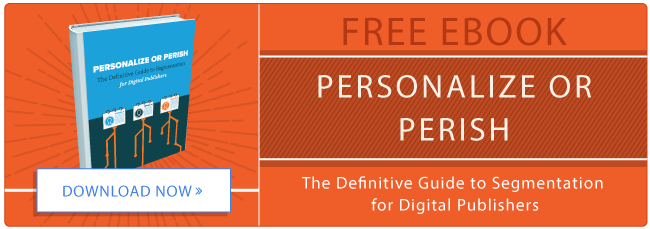
Personalization is a growing segment of online marketing. If in the past a one-size-fits-all was enough, today’s audience demands more. The idea behind personalization is a straightforward one: personalize your message and you’ll see better results. Think about it like calling someone by their name instead of just shouting, “Hey you”; in which case are you more likely to get a response?
Be Personal, Be Relevant
Publishers are attempting to personalize the entire online experience, with personalized recommendations becoming a central tool for driving anonymous readers into deeper engagement and interaction. These personalized recommendations can come in the form of popups, calls-to-action, email segmentation, etc., and attempt to deliver the most relevant article or offer to each and every reader.
Relevancy is the name of the game. If you recommended the best and most comfortable ski gear, at an amazing price, to a person who never skied, it’s still not going to work. The quality of the recommendation is important but pales in comparison to the importance of being relevant.
How Personalization Works
So how does it actually work? Personalization can either be rule-based or algorithm-based. With rule-based personalization tools, you define visitor lists and decide what is the best and most relevant content for them. You can segment your visitors in any number of ways, depending on the specific tool you are using. In many cases, self-volunteered information from previous on-site conversions can be most effective.
With personalization algorithms there are two phases: first the system ‘learns’ your site by mapping content such as white papers, case studies and blog posts, using a combination of NLP (natural language processing) textual matching and taxonomy. The result is a content-map of the site, with highlights for unique content.
As a visitor arrives to the site, the algorithm then analyzes their on-site behavior – what was the starting page, what other pages the visitor viewed and how long he stayed on each. The algorithm then matches the two pieces and serves personalized recommendations to the visitor in real time.
Why Do Personalized Recommendations Work?
For many publications, first time visitors are a tough crowd to please. Regardless of how they found your site, they are unfamiliar with what else you may have to offer, or where on your site to find it. By bringing these treasures to the reader, rather then making them hunt around for it, you increase time-on-site, positive user-experience, and click-through rates. Personalized recommendations that work smoothly are like answering a visitor question before it is being asked.
Additionally, personal recommendations evoke emotions from the website visitor. Not heavy-handed emotions like happiness or anger, but more a faint sense of credibility and trust.
As a digital publisher, personalized recommendations are a smart way to bring back your articles or content offers from the abyss. Your entire content arsenal is put into good use, and nothing goes to waste.
What to Consider When Using Personalized Recommendations
To Gate or Not to Gate?
The first thing to decide is whether to gate your content, and how much of it to gate. And finding the right balance of gated vs. open content is delicate work.
In short, you need to consider the overall website experience . If you are gating too little of your content, you miss opportunities to convert. That said, readers typically need to first consume and enjoy several pieces of ungated content to consider giving up their personal information to business.
Recommendations or Offers?
The next decision publishers face is whether to use on-site content recommendations or offer recommendations (which can be personalized too). Let’s say a visitor to a magazine’s website checks out the subscription page, but does not convert. You might consider serving them a personalized offer on the next page they visit for a 50% discount on their first month of subscription.
Deciphering when to serve recommendations during natural browsing is like preparing for a meeting with a client. You plan what you are going to say, in what order, what visual aides you are going to present and when. Serving personalized recommendations is quite similar—you need to know your website inside out, and understand how visitors use it. From that you can conclude when questions might arise and how to answer them with personalized content recommendations. Also, think how to enrich each users’ interactions with added value content and relevant offers.
Timing is Everything
Personalized recommendations all boil down to a few motivations—to increase engagement and ultimately conversions. Be it leads for advertisers, newsletter subscriptions, or anything else that helps meet your marketing goals. So when do you ask your readers for a commitment beyond reading another article?
You need to evaluate engagement and set the right parameters for when to recommend more substantial offers. Only after the reader’s interest has been established beyond doubt should you attempt to re-define their motives for being on your site. For example, after recommending one or two on-site articles, on which the reader clicks and stays on your site, then you should go ahead and offer a newsletter subscription.
The Secret is Not in the Sauce, It’s in You
Registering for a newsletter is a sign of trust. Publishers can earn this trust by making recommendations that their readers appreciate, and only asking for larger commitments when the time is right. Instill the notion that your content is beneficial for them, and easy to navigate. This type of trust can happen instantaneously, or take time – but either way it’s worth it in the long run for the health of your database, advertiser revenue, newsletter, publication, and more.
from HubSpot Marketing Blog http://blog.hubspot.com/marketing/how-to-increase-newsletter-subscriptions-with-personalized-recommendations
Via http://blog.hubspot.com/marketing/how-to-increase-newsletter-subscriptions-with-personalized-recommendations

No comments:
Post a Comment